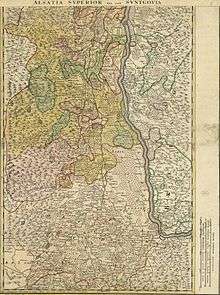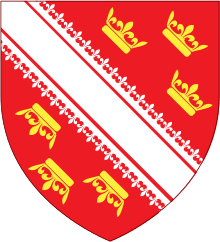Upper Alsace
Upper Alsace[lower-alpha 1] (southern Alsace) was a landgraviate of the Holy Roman Empire centred on Ensisheim and Landser, north of the County of Ferrette (Pfirt). The counts of Habsburg ruled the territory from the 1130s down to its cession to France in the 17th century.[1]

Albert III, Count of Habsburg, received the landgraviate of Upper Alsace from the Emperor Frederick I in 1186. Frederick's son, Duke Frederick V, was his lord with the title of Duke of Alsace (Elisatiae dux).
On 9 May 1469, Duke Charles the Bold of Burgundy acquired the landgraviate of Upper Alsace and the county of Ferrette for 50,000 Rhenish florins.[2] At the time of its purchase, the landgraviate was heavily mortgaged and pawned. Landser was mortgaged to Thüring von Hallwill for 7,000 florins. On 20 September Charles appointed Peter von Hagenbach as the "grand bailiff (Landvogt) of Ferrette and Alsace" with his seat at Ensisheim. This official was a successor of the previous Austrian-appointed Landvogt, and thus in the service of the landgrave of Upper Alsace. The Landvogtei (bailiwick) of Alsace itself was an imperial office then mortgaged to the Electoral Palatinate.[2]
On 14 April 1646, the imperial ambassador Trauttmansdorff, during negotiations to end the Thirty Years' War, offered "Upper and Lower Alsace and the Sundgau, under the title of Landgraviate of Alsace" to the French.[3] There was no such territory, since Alsace was at the time divided into several jurisdictions held by competing powers. The Archduke Ferdinand Charles held the landgraviate of Upper Alsace, while a relative held the Landvogtei (bailiwick) of Hagenau with a protectorate over the Décapole (a league of ten imperial cities).[4]
Notes
- Known in French as Haute-Alsace, in German Oberelsaß
References
- Arnolf 1991, pp. 131–32, 273.
- Vaughan, pp. 86–89.
- Croxton, pp. 225–26.
- Beller 1970, p. 353.
Bibliography
- Arnold, Benjamin (1991). Princes and Territories in Medieval Germany. Cambridge University Press.
- Beller, E. A. (1970). "The Thirty Years War". In Cooper, J. P. (ed.). The New Cambridge Modern History, Volume 4: The Decline of Spain and the Thirty Years War, 1609–48/49. Cambridge University Press.
- Croxton, Derek (2013). Westphalia: The Last Christian Peace. Palgrave MacMillan.
- Vaughan, Richard (1973). Charles the Bold: The Last Valois Duke of Burgundy. Longman.

.svg.png)